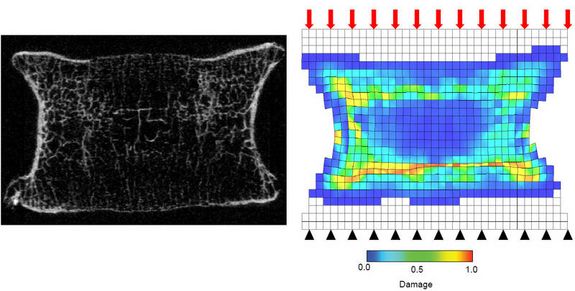Vienna (TU). Nowadays, information about bone density are obtained with the help of the DXA measurement method, where two low-intensity x-ray beams are sent through bones in the hip and in the lumbar spine. Based on the collected data, the World Health Organisation defines the degree of osteoporosis and predictions can be made about the risk of fracture. A new ‘anabolic’ medication, based on the recombinant human parathormone fragment Teriparatide, should help people suffering from an advanced stage of bone loss. This anabolic treatment holds the promise of bone growth. “We were asked to monitor the mechanical effects of this growth over a period of two years by applying the finite element method to the recorded patient data. In collaboration with Prof. Claus Glüer of Schleswig-Holstein University Hospital, we used three-dimensional images from computer tomography to gain informations about the geometry and the material properties of the bone ”, explains Professor Philippe Kurt Zysset from the Institute of Lightweight Design and Structural Biomechanics at TU Vienna.
From such images, Zysset and his team develop mechanical models and simulate the mechanical behaviour of bones under various loading conditions. The reliability of these numerical simulations is continuously examined in the laboratory through biomechanical tests. Lilly, the international pharmaceutical company, used the results obtained by TU’s biomechanical engineers to interpret a two-year clinical study in which 44 patients were treated with Teriparatid products and bone growth was to be demonstrated. Zysset says: “The patients’ thoracic vertebra T12 was examined using computer tomography before the start of treatment and after 6, 12 and 18 months,. This allowed us to calculate the change in vertebral strength, and we established that it has increased as a result of the treatment. This method provides more meaningful results than pure density measurements (DXA). After two years we demonstrated a mean increase of 30% in bone strength.”
Another medication, already available on the market for some time and known as an ‘antiresorptive’, employs the strategy of preventing or delaying bone loss in osteoporosis patients. There are plans to continue these investigations by comparing the effect of ‘antiresorptives’ with that of ‘anabolic’ drugs in patients with glucocorticoid-induced osteoporosis.
Photo download: <link>www.tuwien.ac.at/index.php
Enquiries:
Prof. Philippe Kurt Zysset
Vienna University of Technology
Institute of Lightweight Design and Structural Biomechanics
27-29 // 317 Gusshausstrasse, 1040 Vienna, Austria
T +43/1/58801 - 31723
F +43/1/58801 - 31799
E <link>philippe.kurt.zysset@tuwien.ac.at
Sent by:
Mag. Daniela Hallegger
TU Vienna - PR and Communication
13/E011 Karlsplatz, A-1040 Vienna, Austria
T +43-1-58801-41027
F +43-1-58801-41093
E <link>daniela.hallegger@tuwien.ac.at
<link http: www.tuwien.ac.at pr>www.tuwien.ac.at/pr

